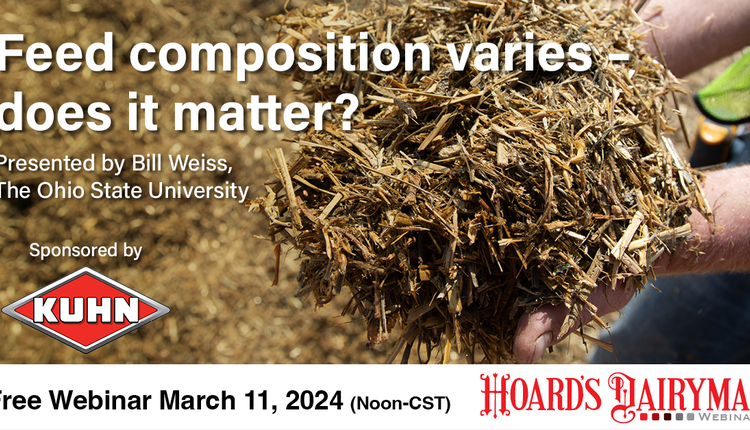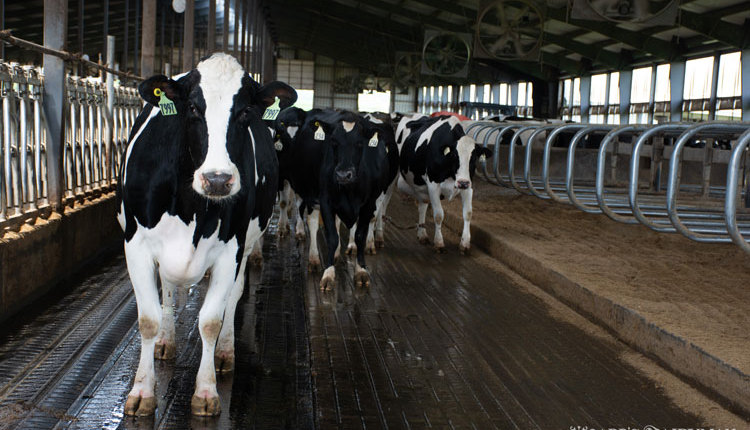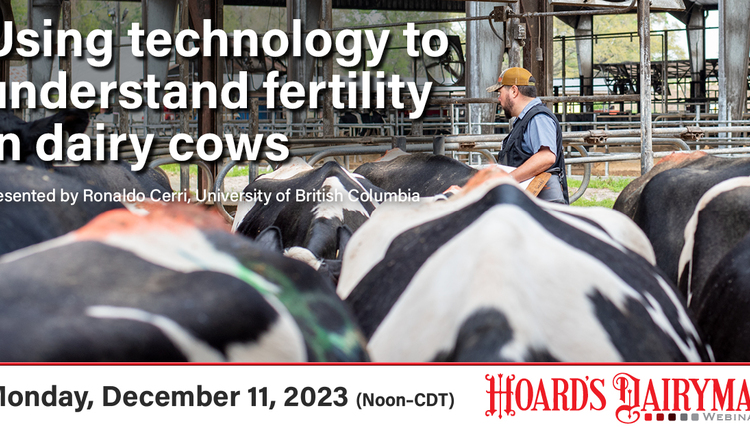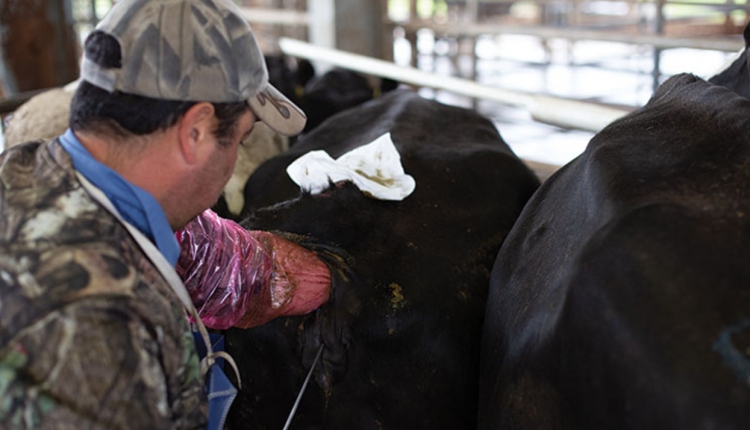The author is professor of animal sciences at Kansas State University, Manhattan.
One of the exciting areas of research in which nutrition may impact reproductive performance are the results from many experiments feeding fats. These fats may be a big boost to improving lactating dairy cow fertility. At the third annual Dairy Cattle Reproductive Council convention that was recently held in Omaha, Charles Staples, Jose Santos, and Bill Thatcher of the University of Florida summarized the effects of feeding fats or fatty acids on reproduction.
Fat options are plentiful . . .
Many types of supplemental fat fed to lactating dairy cows have included tallow and yellow grease. Likewise, oils from canola, cottonseed, flaxseed, rapeseed, safflower, soybean, sunflower, and Menhaden fish have been fed in addition to three commercially available products. These fats are composed of various mixes of individual fatty acids, including myristic, palmitic, palmitoleic, stearic (C18:0), oleic (C18:1), linoleic (C18:2), and linolenic (C18:3). Linoleic and linolenic acids are essential for good reproduction and must be included in the diet to meet cow requirements.
Rumen microbes convert essential fatty acids to nonessential fatty acids by saturating them with hydrogen atoms or what is called biohydrogenation. The majority of the essential fatty acids containing 18 carbons, with two double bonds (C18:2) or three double bonds (C18:3), are converted by rumen bacteria to stearic acid (C18:0).
For example, a typical lactating cow diet contains approximately 20 grams of C18:0, 280 grams of C18:2, and 40 grams of C18:3. After rumen bacterial digestion, approximately 370 grams of C18:0, 40 grams of C18:2, and 4 grams of C18:3 will leave the rumen.
Only 10 to 14 percent of the essential fatty acids (C18:2 and C18:3) escaped rumen biohydrogenation. Some intermediate forms of these fatty acids appear in the rumen, and they can influence metabolism and lead to milkfat depression. Thus, many commercial products have endeavored to protect supplemental fatty acids so they can bypass rumen biohydrogenation and then be absorbed in the small intestine.
Seventeen studies involving 3,427 dairy cows reported significantly improved conception rates when fed supplemental fatty acids (48 versus 60 percent). This summary included first-service conception rates and conception rates of repeated inseminations. Charles Staples emphasized that this 12 percentage unit boost in conception does not mean that each dairy would see that large of an increase because many biological and management interactions prevent conception.
In contrast, 17 other studies reported a negative effect or no significant improvement in conception rates when diets were supplemented with fatty acids. These studies included 2,689 cows, and the controls averaged 42 percent compared with 42 percent in fat-supplemented cows.
In those studies where reproduction was improved, it is difficult to determine which fat supplements or which fatty acids were beneficial. When cows were fed fats containing mostly palmitic and oleic acids, conception rates were greater than in cows fed a no-supplemental fat control diet. In other comparisons, cows fed Ca-salts of palm oil did not conceive as well as those fed formaldehyde-treated flaxseed, a Ca-salt mixture of soybean oil and mono-unsaturated trans-fatty acids, and a Ca-salt mixture of palm oil and fish oil.
Therefore, fats containing mainly palmitic and oleic acids may not be as effective as those containing the omega-6 and/or omega-3 fatty acids. Four studies feeding flaxseed reported no increase in conception rate, but embryo survival was improved by feeding flaxseed.
Inclusion of fish as meal or oil in the diet improved reproductive performance in five studies.
In a recently completed Florida study, where 1,069 cows were fed a Ca-salt of fat enriched fish oil (1.5 percent of diet dry matter) starting 30 days after calving, pregnancy rates were improved from 46 to 53 percent compared with a diet containing a Ca-salt of palm oil. Further, embryo loss also dropped from 12 to 6 percent.
Most oil seeds have not been evaluated for their ability to improve conception. Although oil in many oil seeds contains more than 50 percent C18:2, the delivery of C18:2 past the rumen to the small intestine is not similar for all oil seeds. Based on C18:2 content in milkfat, soybeans seem to be more effective than cottonseeds in delivering C18:2 to body tissues. Sunflower seeds and safflower seeds can increase C18:2 in milkfat, but not as well as soybeans. Processing, such as roasting of soybeans or rolling of sunflower seeds, seems to increase delivery of C18:2 to tissues. Whole flaxseeds fed at 10 percent of the diet can deliver some C18:3 to tissues; grinding flaxseed may deliver even more C18:3.
How it works . . .
Fat may improve reproduction for multiple reasons:
• Larger ovarian follicles capable of producing more estrogen
• A larger corpus luteum and more progesterone after ovulation
• Better quality embryos
• Less embryonic loss
• Satisfying an essential fatty acid requirement of the cow
• Improving immune status

Oils from cottonseed, flaxseed, rapeseed, safflower, soybean, sunflower, and Menhaden fish
may add fatty acids essential for good reproduction.
For many years, it has been known that early postpartum cows usually produce more milk when fed moderate levels of supplemental fat. Fat sources enriched in omega-6 or omega-3 fatty acids that deliver these fats to tissues beyond the rumen may be the most effective ones to feed, but other fats having small amounts of these omega fatty acids also have improved conception rates in single studies. Fats comprised at least 1.5 percent of the dietary dry matter in studies with improvements to conception rates.
Consult your nutritionist for help in improving reproduction in your herd by feeding fats.
090110_24
One of the exciting areas of research in which nutrition may impact reproductive performance are the results from many experiments feeding fats. These fats may be a big boost to improving lactating dairy cow fertility. At the third annual Dairy Cattle Reproductive Council convention that was recently held in Omaha, Charles Staples, Jose Santos, and Bill Thatcher of the University of Florida summarized the effects of feeding fats or fatty acids on reproduction.
Fat options are plentiful . . .
Many types of supplemental fat fed to lactating dairy cows have included tallow and yellow grease. Likewise, oils from canola, cottonseed, flaxseed, rapeseed, safflower, soybean, sunflower, and Menhaden fish have been fed in addition to three commercially available products. These fats are composed of various mixes of individual fatty acids, including myristic, palmitic, palmitoleic, stearic (C18:0), oleic (C18:1), linoleic (C18:2), and linolenic (C18:3). Linoleic and linolenic acids are essential for good reproduction and must be included in the diet to meet cow requirements.
Rumen microbes convert essential fatty acids to nonessential fatty acids by saturating them with hydrogen atoms or what is called biohydrogenation. The majority of the essential fatty acids containing 18 carbons, with two double bonds (C18:2) or three double bonds (C18:3), are converted by rumen bacteria to stearic acid (C18:0).
For example, a typical lactating cow diet contains approximately 20 grams of C18:0, 280 grams of C18:2, and 40 grams of C18:3. After rumen bacterial digestion, approximately 370 grams of C18:0, 40 grams of C18:2, and 4 grams of C18:3 will leave the rumen.
Only 10 to 14 percent of the essential fatty acids (C18:2 and C18:3) escaped rumen biohydrogenation. Some intermediate forms of these fatty acids appear in the rumen, and they can influence metabolism and lead to milkfat depression. Thus, many commercial products have endeavored to protect supplemental fatty acids so they can bypass rumen biohydrogenation and then be absorbed in the small intestine.
Seventeen studies involving 3,427 dairy cows reported significantly improved conception rates when fed supplemental fatty acids (48 versus 60 percent). This summary included first-service conception rates and conception rates of repeated inseminations. Charles Staples emphasized that this 12 percentage unit boost in conception does not mean that each dairy would see that large of an increase because many biological and management interactions prevent conception.
In contrast, 17 other studies reported a negative effect or no significant improvement in conception rates when diets were supplemented with fatty acids. These studies included 2,689 cows, and the controls averaged 42 percent compared with 42 percent in fat-supplemented cows.
In those studies where reproduction was improved, it is difficult to determine which fat supplements or which fatty acids were beneficial. When cows were fed fats containing mostly palmitic and oleic acids, conception rates were greater than in cows fed a no-supplemental fat control diet. In other comparisons, cows fed Ca-salts of palm oil did not conceive as well as those fed formaldehyde-treated flaxseed, a Ca-salt mixture of soybean oil and mono-unsaturated trans-fatty acids, and a Ca-salt mixture of palm oil and fish oil.
Therefore, fats containing mainly palmitic and oleic acids may not be as effective as those containing the omega-6 and/or omega-3 fatty acids. Four studies feeding flaxseed reported no increase in conception rate, but embryo survival was improved by feeding flaxseed.
Inclusion of fish as meal or oil in the diet improved reproductive performance in five studies.
In a recently completed Florida study, where 1,069 cows were fed a Ca-salt of fat enriched fish oil (1.5 percent of diet dry matter) starting 30 days after calving, pregnancy rates were improved from 46 to 53 percent compared with a diet containing a Ca-salt of palm oil. Further, embryo loss also dropped from 12 to 6 percent.
Most oil seeds have not been evaluated for their ability to improve conception. Although oil in many oil seeds contains more than 50 percent C18:2, the delivery of C18:2 past the rumen to the small intestine is not similar for all oil seeds. Based on C18:2 content in milkfat, soybeans seem to be more effective than cottonseeds in delivering C18:2 to body tissues. Sunflower seeds and safflower seeds can increase C18:2 in milkfat, but not as well as soybeans. Processing, such as roasting of soybeans or rolling of sunflower seeds, seems to increase delivery of C18:2 to tissues. Whole flaxseeds fed at 10 percent of the diet can deliver some C18:3 to tissues; grinding flaxseed may deliver even more C18:3.
How it works . . .
Fat may improve reproduction for multiple reasons:
• Larger ovarian follicles capable of producing more estrogen
• A larger corpus luteum and more progesterone after ovulation
• Better quality embryos
• Less embryonic loss
• Satisfying an essential fatty acid requirement of the cow
• Improving immune status

may add fatty acids essential for good reproduction.
For many years, it has been known that early postpartum cows usually produce more milk when fed moderate levels of supplemental fat. Fat sources enriched in omega-6 or omega-3 fatty acids that deliver these fats to tissues beyond the rumen may be the most effective ones to feed, but other fats having small amounts of these omega fatty acids also have improved conception rates in single studies. Fats comprised at least 1.5 percent of the dietary dry matter in studies with improvements to conception rates.
Consult your nutritionist for help in improving reproduction in your herd by feeding fats.
090110_24










